#tutankhamun curse
Explore tagged Tumblr posts
Text

‘Curse’ Behind King Tutankhamun’s Tomb Mysterious Deaths Finally Solved
The unsettling curse of King Tutankhamun’s tomb in Egypt has bewildered archaeologists since it’s been feared to be linked to the mysterious deaths of multiple excavators who discovered it in 1922.
However, a scientist now claims to have solved the mysteries of the infamous “Pharaoh’s Curse” more than 100 years later.
Toxic levels of radiation emanating from uranium and poisonous waste are believed to have lingered inside the tomb since it was sealed over 3,000 years ago, Ross Fellowes wrote last month in the Journal of Scientific Exploration (JSE).

The burial chamber in the tomb of Tutankhamun, near Luxor, Egypt.
The radiation level inside Tutankhamun’s tomb is so high that anyone who comes in contact with it could very likely develop a fatal dose of radiation sickness and cancer.
“Both contemporary and ancient Egypt populations are characterized by unusually high incidences of hematopoietic cancers, of bone/blood/lymph, for which a primary known cause is radiation exposure,” Fellowes wrote in his study.
However, this radioactivity isn’t isolated to Tutankhamun’s tomb.
Fellowes revealed that “unusually high radiation levels have been documented in Old Kingdom tomb ruins” and spread throughout sites in Egypt.
“Radiation has been detected by the Geiger counter at two sites at Giza adjacent to the pyramids,” he wrote, adding that radon — a radioactive gas — has also been detected in “several underground tombs at Saqqara.”

The “Coffinette for the Viscera of Tutankhamun,” which contained the king’s mummified liver, depicts him as Osiris, holding a crook and flail.

Medical imagery of Tutankhamun is shown above a replica of King Tut’s skull on display during the “Tutankhamun And The Golden Age Of The Pharaohs” at the Los Angeles County Museum of Art in California.
These readings were all found to be “intensely radioactive.”
“Modern studies confirm very high levels of radiation in ancient Egyptian tombs, in the order of 10x accepted safety standards,” the study shared.
It’s also theorized that those who built the ancient tombs were aware of the toxins based on the eerie warnings carved on the walls.
“The nature of the curse was explicitly inscribed on some tombs, with one translated presciently as, ‘they that break this tomb shall meet death by a disease that no doctor can diagnose,’” Fellowes wrote.
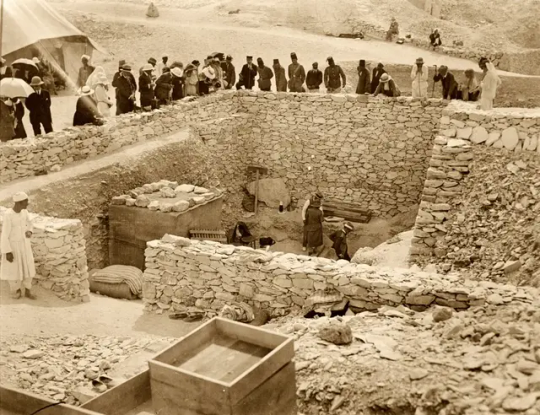
Outside the tomb of Tutankhamun during the 1922 excavation in the Valley of the Kings in Egypt.
Other ominous translations like “forbidden” because of “evil spirits” may have significantly fueled the fear that supernatural curses lingered in the ancient sites.
Those fears intensified with the mysterious deaths of Lord Carnarvon, who funded the excavation in 1922 and reportedly walked through the treasured filled rooms — and multiple others after they unsealed the tomb.
“Carnarvon was dead within a few weeks of the uncertain diagnosis of blood poisoning and pneumonia,” Fellowes wrote.
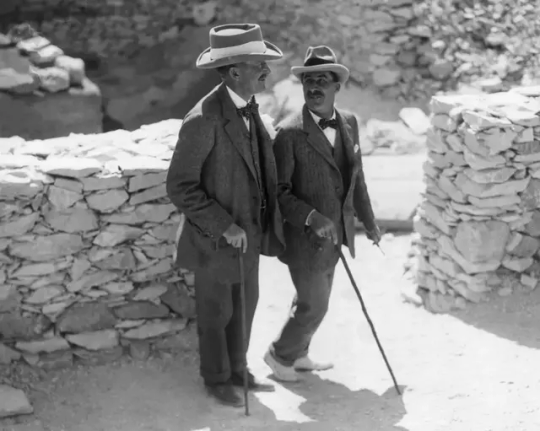
Egyptologist Howard Carter (R) walks with archaeologist Lord Carnarvon, the patron of his research, outside the tomb of King Tutankhamun in 1922.
Egyptologist Arthur Weigall allegedly told colleagues that Carnarvon would “be dead within six weeks” upon entering, the study claimed.
Howard Carter, the first person to walk inside Tutankhamun’s tomb with Carnarvon, died in 1939 after a long battle with Hodgkin’s lymphoma, which was suspected to be caused by radiation poisoning.
British Egyptologist and independent excavator Arthur Weigall was present at the opening of Tut’s Tomb and is also credited with starting the ‘myth’ of the curse.
He died of cancer at 54 years old in 1934.
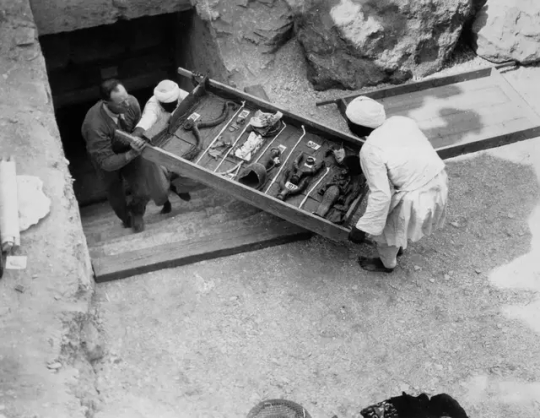
Workers remove a tray of chariot parts from the Tomb of Tutankhamun in the Valley of the Kings, Egypt, in 1922.
In total, six of the 26 people present when the tomb was opened died within a decade from asphyxia, stroke, diabetes, heart failure, pneumonia, poisoning, malaria and X-ray exposure.
While the deaths can be seen as odd, the curse theory was also likely fueled by the oddities that happened when it opened.
Carnarvon had reportedly suffered a mosquito bite that became severely infected.
Around the time excavators opened the tomb, Cairo reportedly suffered a bizarre power outage and a freak sandstorm, according to National Geographic.’
At one point during the excavation, Carnarvon’s favorite dog allegedly let out a chilling howl and suddenly dropped dead.
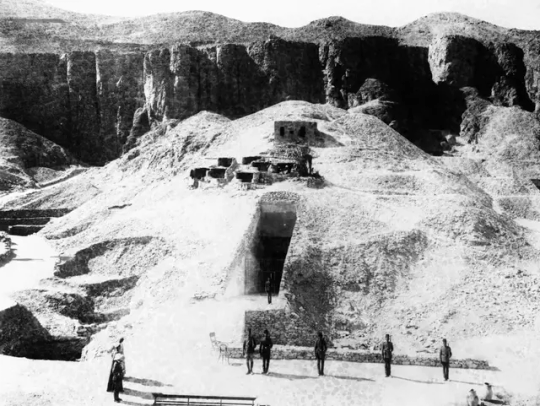
A photograph showing guards standing outside the tomb of Tutankhamun in Egypt in 1922.
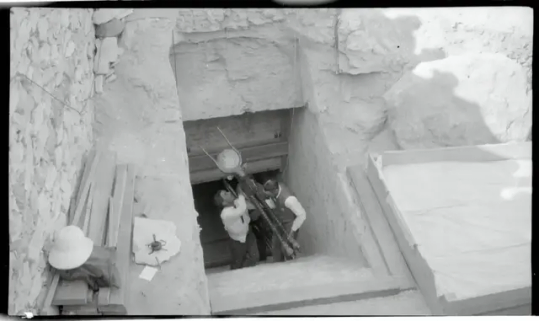
A sacred cow being removed from Tomb of Tutankhamun in 1922.
From a historical perspective, the discovery of the tomb in the Valley of Kings is considered one of the most fascinating finds that gave modern society a glimpse into the Egyptian royalty voyage into the afterlife.
Five thousand items, including solid gold funeral shoes, statues, games, and strange animals, were discovered inside Tutankhamun’s tombs.
It would take the excavators ten years to clear the tomb of its treasure.

The golden funerary mask of Tutankhamun.
The unsealing and studying of the tomb is also credited with launching the modern era of Egyptology.
Tutankhamun took the throne as pharaoh around nine or ten years old and ruled between 1332 BC and 1323 BC.
However, he died by the time he turned 18.
There are no surviving records of Tutankhamun’s death and how the young pharaoh died remains a mystery.
However, Tutankhamun is suspected to have suffered from several health issues — likely linked to his father, Akhenaten, and his mother, Nefertiti, being brother and sister.
By Richard Pollina.
#‘Curse’ Behind King Tutankhamun’s Tomb Mysterious Deaths Finally Solved#King Tutankhamun#Pharaoh’s Curse#Old Kingdom#Valley of the Kings#Lord Carnarvon#Howard Carter#Egyptology#ancient artifacts#archeology#archeolgst#history#history news#ancient history#ancient culture#ancient civilizations#ancient egypt#egyptian history#egyptian mythology#egyptian pharaoh#egyptian antiquities#egyptian art
78 notes
·
View notes
Text
5 Surprising Facts About Howard Carter:
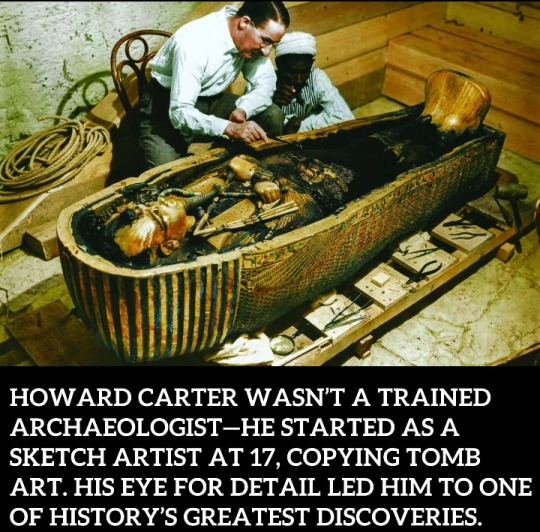
#1

#2

#3
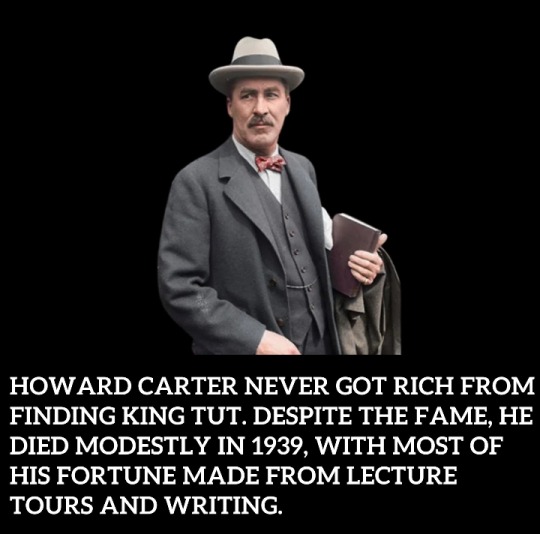
#4
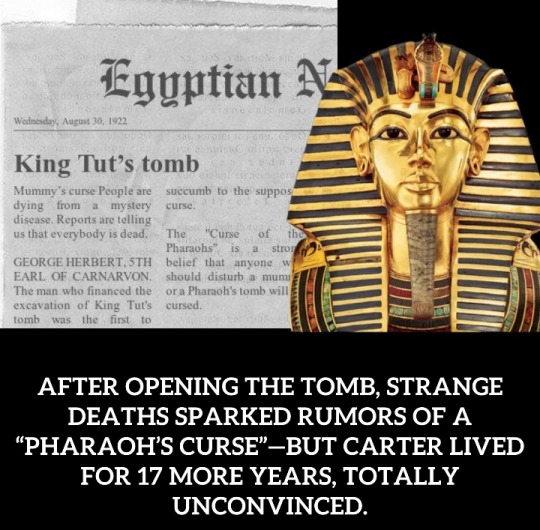
#5
—
Howard Carter (9 May 1874 – 2 March 1939) was a British archaeologist and Egyptologist who discovered the intact tomb of the 18th Dynasty Pharaoh Tutankhamun in November 1922, the best-preserved pharaonic tomb ever found in the Valley of the Kings.
#howard carter#archaeology#egyptology#tutankhamun#18th Dynasty#pharaoh tutankhamun#king tut#pharaonic tomb#valley of the kings#egypt#intact tomb#discovery#pharaoh's curse#lord carnarvon#tomb
15 notes
·
View notes
Text
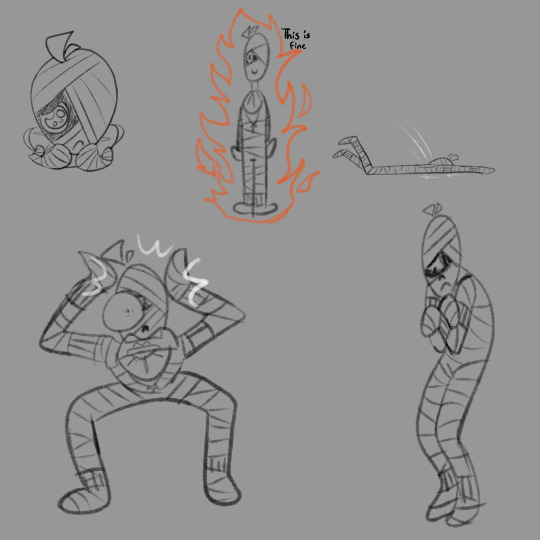
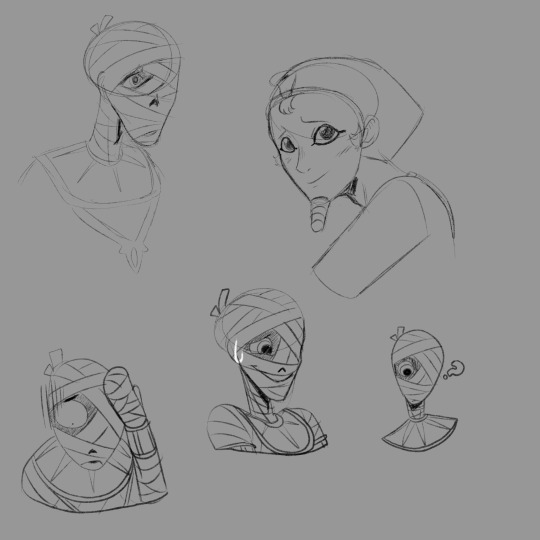
Prince tut doodles
#satcm#sphinx and the cursed mummy#sphinx#doodle#tutankhamun#SATCM tutankhamen#Yes Its spelled like that#In game#digital art#sphinx art#binckus art#obscure games#video games
24 notes
·
View notes
Text



my reimagining of Tutankhamen from Sphinx and the Cursed Mummy. thought he could use a sweet helm for security reasons.
72 notes
·
View notes
Text
imagine trying to casually use the bathroom and then Tutankhamun just goes:
PHARAOHS CURSE, DAMN THIS MAN, TURN HIS TOILET INTO SAND
and then your day is ruined :(
13 notes
·
View notes
Text
November 26, 1922: Howard Carter Peers Inside King Tutankhamun’s Tomb – A Treasure Trove of Language and History
Howard Carter’s 1922 discovery of King Tutankhamun’s tomb enriched English with terms like “pharaoh” and “sarcophagus,” and sparked “Tutmania.” The find shaped archaeology and cultural imagination globally.
November 26, 1922 On November 26, 1922, British archaeologist Howard Carter became the first person in over three millennia to glimpse the contents of the sealed tomb of King Tutankhamun, one of ancient Egypt’s most enigmatic pharaohs. As Carter peered into the tomb, Lord Carnarvon, his patron, reportedly asked, “Can you see anything?” Carter’s legendary response, “Yes, wonderful things,” marked…

View On WordPress
#1922#africa#ancient Egypt vocabulary#Curse of the Pharaohs#egypt#Egyptian artifacts#history#Howard Carter#Howard Carter archaeology#King Tut discovery#November 26#travel#tutankhamun#Tutankhamun tomb#Tutmania influence
0 notes
Text
The Curse of Tutankhamun
By Derek Olson It’s 1922 in Thebes, Egypt, and the esteemed archaeologist, Howard Carter, alongside his financial backer, Lord Carnarvon, holds a flickering match up to the darkness. They’re underneath the Egyptian sand, at the mouth of the tomb of the Boy Pharaoh Tutankhamen. Hot air, trapped for 1000s of years, escapes the ancient doorway… “…As my eyes grew accustomed to the light, details of…

View On WordPress
0 notes
Text
so apparently tutankhamun's curse was just uranium poisoning. Ancient egyptians were great pranksters I guess.
0 notes
Text
The Curse of the Pharaohs: Unveiling Tutankhamun's Tomb
Behold the majesty of King Tut’s death mask, a stunning artifact shrouded in the mystery of the Curse of the Pharaohs. The Curse of the Pharaohs has fascinated and chilled the spines of many since the discovery of Tutankhamun’s tomb. This legendary curse is said to bring misfortune to those who disturb the resting place of an Ancient Egyptian Pharaoh. Let’s explore the mystery surrounding…
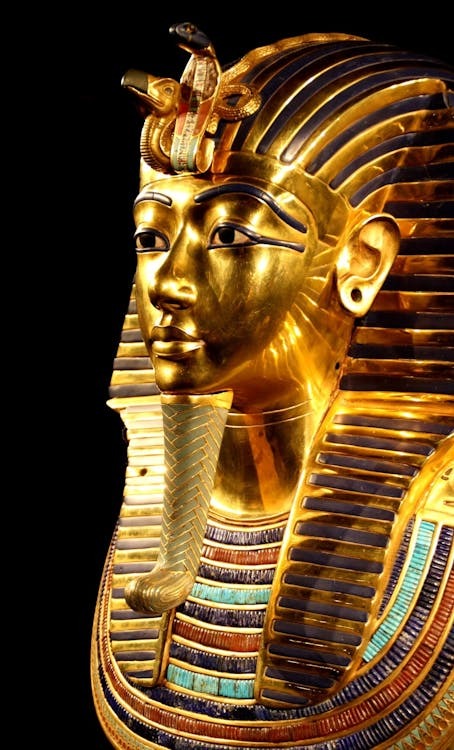
View On WordPress
#archaeological mysteries#Curse of the Pharaohs#Egyptian Pharaohs#Howard Carter#Tutankhamun&039;s tomb
0 notes
Text
The Haunted Mysteries of Egypt's Valley of the Kings
In the mysterious Valley of the Kings, among the tombs of Pharaohs and their Queens, it is said that some are still lingering. Visitors claim to have seen a spectral figure on horse as well as the infamous curse of the tomb of Tutankhamun still linger
In the mysterious Valley of the Kings, among the tombs of Pharaohs and their Queens, it is said that some are still lingering. Visitors claim to have seen a spectral figure on horse as well as the infamous curse of the tomb of Tutankhamun still haunts the empty graves. The Valley of the Kings in Egypt along the Nile’s western bank, is renowned for its regal tombs and the treasures they hold.…
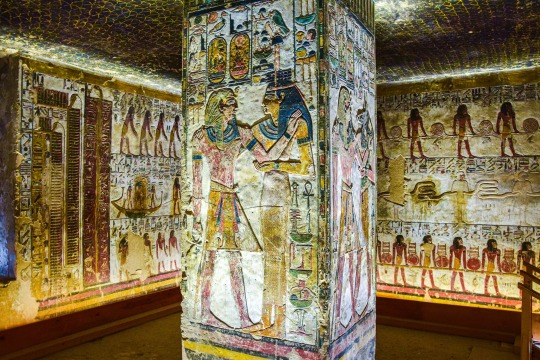
View On WordPress
2 notes
·
View notes
Note
Can I ask for some fun facts about King Tut
You may ask, but I never, ever do requests such as this, nor will I ever write any fun facts about King Tut. Here are some fun facts about King Tut as per your request-
Tutankhamun was a god-king of Ancient Egypt, but was denied a pyramid in death because that was just so 1500 years earlier.
He only lived to be a teenager, and was thus never allowed to buy alcohol or cigarettes, or to rent a car. His autobiography states this was always his greatest regret.
His tomb was one of the few not looted by grave robbers before it was discovered by the British explorers in 1922, who celebrated its pristine untouched state before looting it as grave robbers.
The curse of King Tut killed all who entered his tomb, insidiously causing their deaths of diverse and unrelated causes from between a few years and a few decades after the tomb was raided. Such was the curse's famous wording, "Death will come on wings taking 6-75 years to whosoever disturbs my tomb."
Tutankhamun's tomb was filled with amazing treasures, including gold masks, gold furniture, and a signed copy of Steve Martin's song about him on vinyl from when it was certified gold.
As scarabs were considered symbols of his divinity and cycle of rebirth, Tutankhamun is considered the first royal fan of The Beetles.
Tutankhamun was not his original name, he was born Tutankhaten, but deleted for a while and when he came back Tutankhaten was taken and Staff (of Ra) wouldn't help.
163 notes
·
View notes
Text
A deadly fungus has been turned into a potent cancer-fighting compound after researchers isolated a new class of molecules from it.
Aspergillus flavus, a toxic crop fungus linked to deaths in the excavations of ancient tombs—such as that of the boy pharaoh Tutankhamon—was recently used in a test against leukemia cells.
The result? A promising cancer-killing compound that rivals FDA-approved drugs and opens up new frontiers in the discovery of more fungal medicines.
“Fungi gave us penicillin,” says Sherry Gao, Presidential Compact Associate Professor at the University of Pennsylvania and senior author of a new paper in Nature Chemical Biologyon. “These results show that many more medicines derived from natural products remain to be found.”
After archaeologists opened King Tutankhamun’s tomb in the 1920s, a series of untimely deaths among the excavation team fueled rumors of a pharaoh’s curse. Decades later, doctors theorized that fungal spores, dormant for millennia, could have played a role.
In the 1970s, a dozen scientists entered the tomb of Casimir IV in Poland. Within weeks, 10 of them died. Later investigations revealed the tomb contained Aspergillus flavus, named for its yellow spores, whose toxins can lead to lung infections, especially in people with compromised immune systems.
Now, that same fungus is the unlikely source of a promising new cancer therapy.
The therapy in question is a class of ribosomally synthesized and post-translationally modified peptides, or RiPPs, pronounced like the “rip” in a piece of fabric. The name refers the ribosome, a tiny cellular structure that makes proteins, including RiPP.
“Purifying these chemicals is difficult,” says Qiuyue Nie, a postdoctoral fellow and the paper’s first author. While thousands of RiPPs have been identified in bacteria, only a handful have been found in fungi. In part, this is because past researchers misidentified fungal RiPPs as non-ribosomal peptides and had little understanding of how fungi created the molecules.
“The synthesis of these compounds is complicated,” adds Nie. “But that’s also what gives them this remarkable bioactivity.”
To find more fungal RiPPs, the researchers first scanned a dozen strains of Aspergillus, which previous research suggested might contain more of the chemicals. By comparing chemicals produced by these strains with known RiPP building blocks, the researchers identified A. flavus as a promising candidate for further study.
Genetic analysis pointed to a particular protein in A. flavus as a source of fungal RiPPs. When the researchers turned the genes that create that protein off, the chemical markers indicating the presence of RiPPs also disappeared.
This novel approach of combining metabolic and genetic information not only pinpointed the source of fungal RiPPs in A. flavus but could be used to find more fungal RiPPs in the future.
After purifying four different RiPPs, the researchers found the molecules shared a unique structure of interlocking rings. The researchers named these molecules, which have never been previously described, after the fungus in which they were found: asperigimycins.
Even with no modification, when mixed with human cancer cells, asperigimycins demonstrated medical potential: two of the four variants had potent effects against leukemia cells.
OTHER GIFTS FROM THE WORLD OF FUNGI: Ingredient Found in All Mushrooms Can Reprogram Immune Cells to Fight Deadly Flu Infections
Another variant, to which the researchers added a lipid, or fatty molecule, that is also found in the royal jelly that nourishes developing bees, performed as well as cytarabine and daunorubicin, two FDA-approved drugs that have been used for decades to treat leukemia.
Inside the leukemia cells, a gene called SLC46A3, proved critical in allowing asperigimycins to enter leukemia cells in sufficient numbers, which has given the team the idea that it might be a pathway for other, already developed remedies called cyclic peptides, to enter and kill a leukemia cell.
“Knowing that lipids can affect how this gene transports chemicals into cells gives us another tool for drug development,” says Nie.
Through further experimentation, the researchers found that asperigimycins likely disrupt the process of cell division. Notably, the compounds had little to no effect on breast, liver or lung cancer cells, or a range of bacteria and fungi, suggesting that asperigimycins’ disruptive effects are specific to certain types of cells, a critical feature for any future medication.
NOVEL CANCER TREATMENTS: Scientists Identify New Way Cancers Sustain Themselves–and How Ginger Could Disrupt it
In addition to demonstrating the medical potential of asperigimycins, the researchers identified similar clusters of genes in other fungi, suggesting that more fungal RiPPs remain to be discovered.
“Even though only a few have been found, almost all of them have strong bioactivity,” says Nie. “This is an unexplored region with tremendous potential.”
“Nature has given us this incredible pharmacy,” says Gao. “It’s up to us to uncover its secrets. As engineers, we’re excited to keep exploring, learning from nature and using that knowledge to design better solutions.”
44 notes
·
View notes
Text
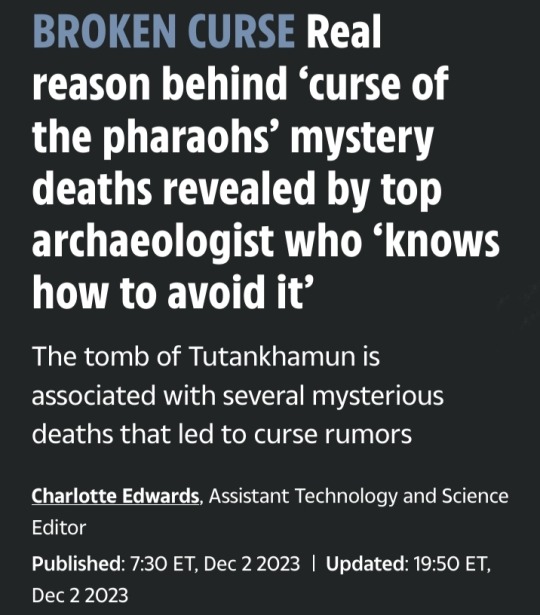
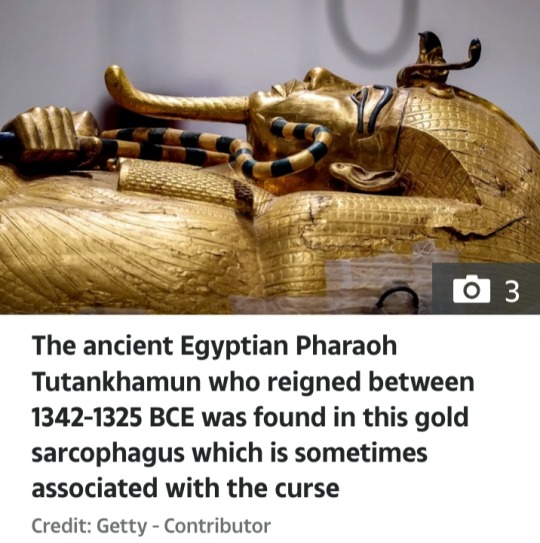
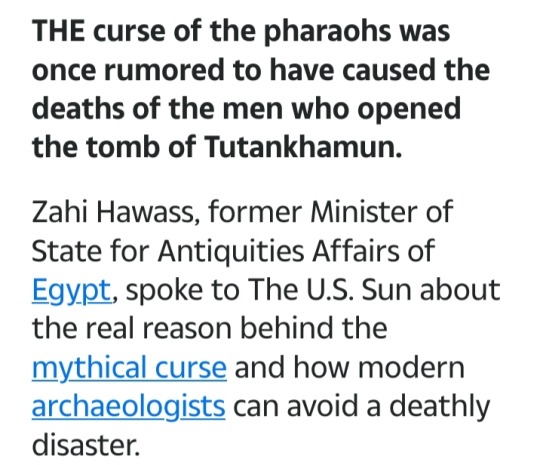
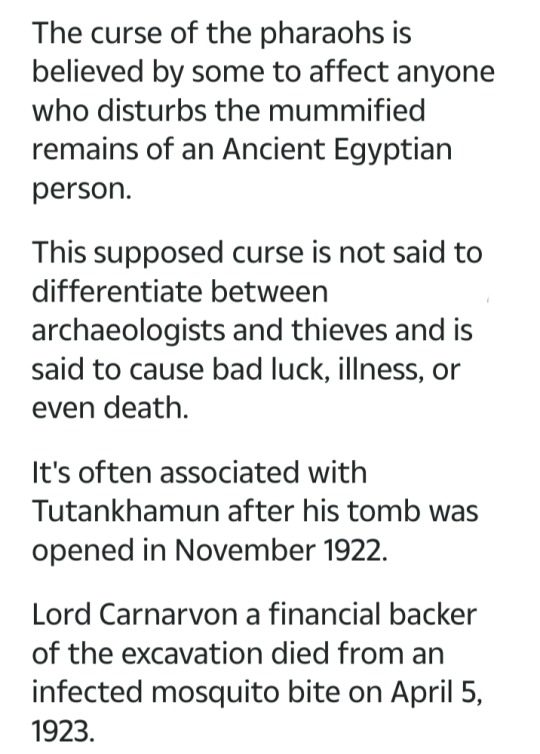
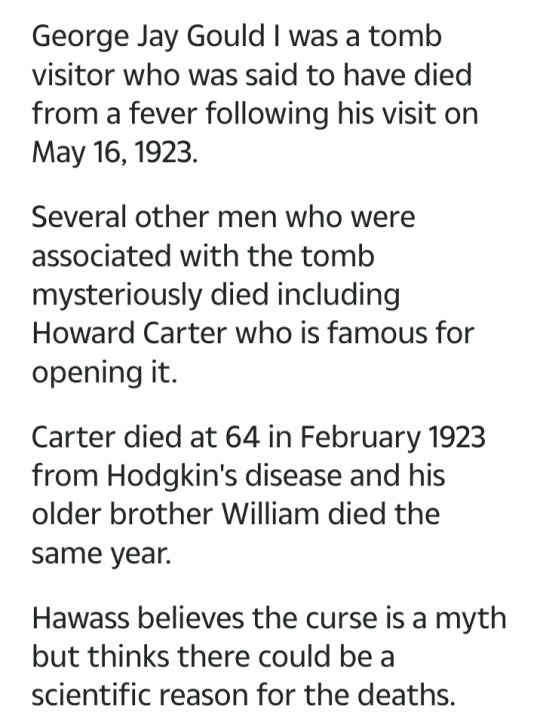
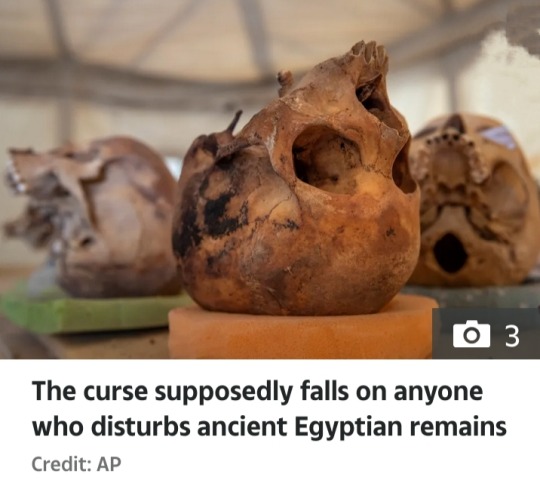
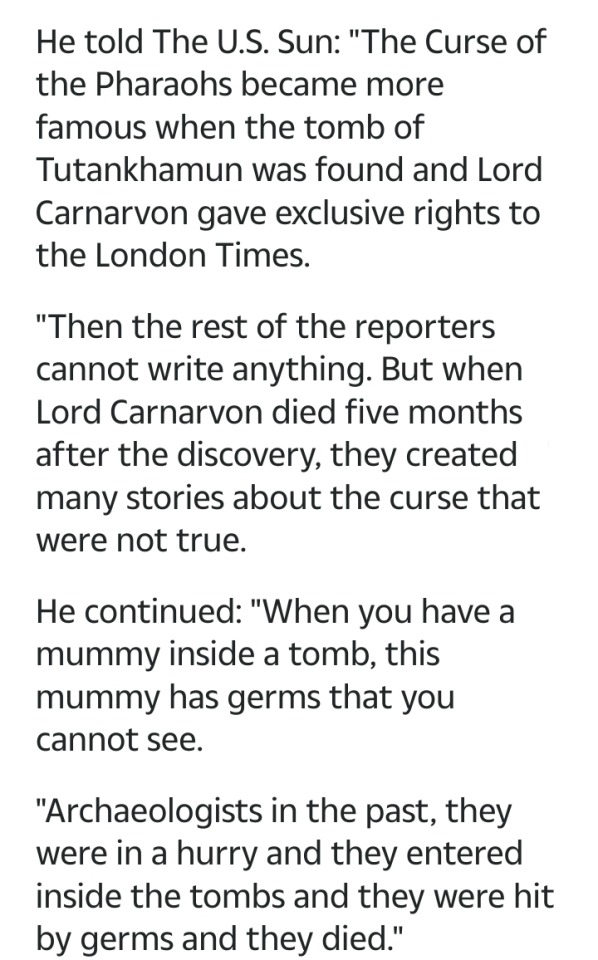
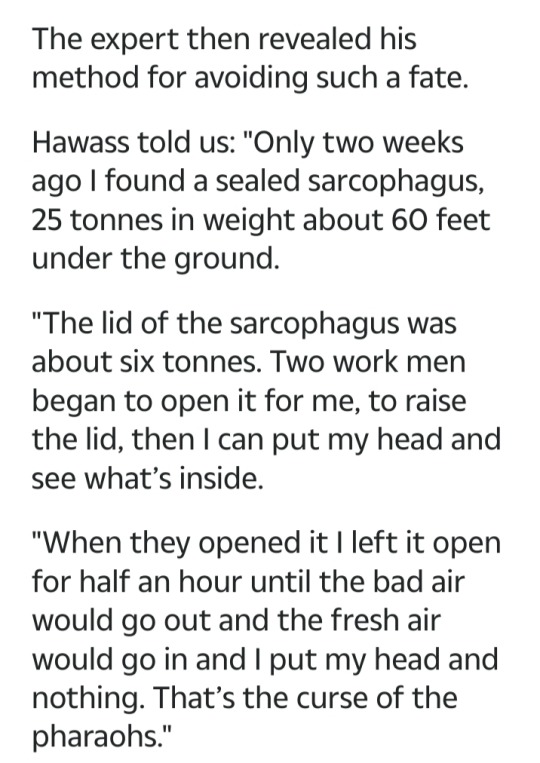


#Tutankhamun#Tomb of Tutankhamun#curse of the pharaohs#Ancient Egypt#Ancient Civilization#Dr Zahi Hawass#Minister of State for Antiquities Affairs#Egypt#mythical curse#archaeology#sarcophagus#mummified remains#Lord Carnarvon#Howard Carter#George Jay Gould I#mummies#germs#curse#Ancient Egyptian Pharaoh
62 notes
·
View notes
Text
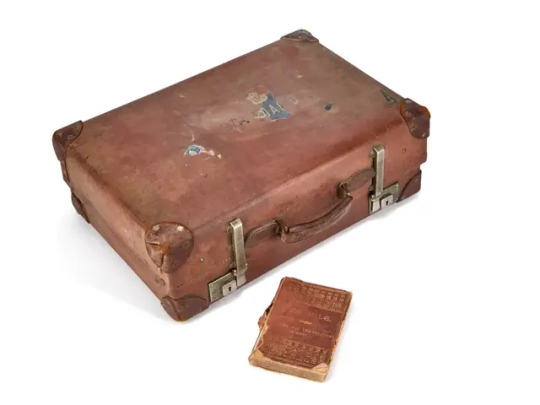
Suitcase Belonging to Legendary Archaeologist Howard Carter Surfaces in England
Howard Carter used the luggage while working in Egypt before giving it to a fellow researcher in 1939. Now, it’s heading to the auction block.
A leather suitcase belonging to archaeologist Howard Carter—the man who found the tomb of King Tut—has been rediscovered in England. The luggage, along with a tattered 1890 guidebook found inside, is now heading to the auction block, where it could fetch as much as $1,900.
Carter used the luggage in Egypt during the 1920s and ’30s before giving it to John Healey, a fellow researcher. The suitcase—marked with the initials “HC”—eventually ended up beneath a bed in the home of Healey’s son, Derek, per BBC Radio.
Derek lives in Bishop Auckland, a town in northeast England. Recently, wishing to sell the luggage, he contacted David Harper, an antiques expert who often appears on history TV programs. Harper documented the story on his YouTube channel.
“The case certainly would not have just carried clothes,” Harper tells the Northern Echo’s Chris Lloyd. “It would have carried important documents, papers and, crucially, artifacts.”

Carter made his career-defining discovery in 1922. He and his team were excavating in Egypt’s Valley of the Kings when they found the four-chamber tomb of the pharaoh Tutankhamun, who ruled Egypt from around 1333 to 1324 B.C.E., during the New Kingdom’s 18th Dynasty.
As Carter wrote of his first look into one of the tomb’s chambers, “At first I could see nothing, the hot air escaping from the chamber causing the candle flame to flicker, but presently, as my eyes grew accustomed to the lights, details of the room within emerged slowly from the mist, strange animals, statues and gold—everywhere the glint of gold.”
Tutankhamun’s tomb was stuffed with precious goods, including chariots, furniture and alabaster vessels. The pharaoh’s mummy had been interred in several layers of nested coffins, including an innermost coffin made of solid gold. Carter quickly became a world-famous archaeologist.
Tutankhamun’s tomb took ten years to clear out. During the 1930s, Carter and Healey became “firm mates” in Egypt, per BBC Radio. Healey was living in Luxor at the time, working as an archaeologist for the University of Chicago’s Oriental Institute. When Carter departed from Egypt for the last time in 1939, he gave his monogrammed suitcase to Healey, who used the case for his own trips between Egypt and England, according to the auction house. Carter also left Healey his copy of The Nile, Notes for Travelers in Egypt, a guidebook published in 1890, which is being sold with the suitcase.
“Everything fits together so well, the Howard Carter link to John Healey,” David Elstob, director of Elstob Auctioneers, tells the Northern Echo. “But the most exciting thing is the potential that it was there when they discovered Tutankhamun’s tomb. It is absolutely fabulous.”
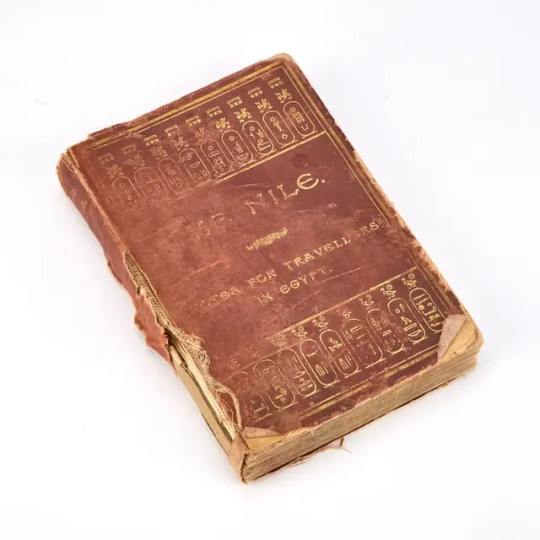
The suitcase was likely ordered in the 1920s, as Harper tells BBC Radio. Its monogram was designed for frequent travel: “Next to the H is a back-to-front C, so no matter what way the case comes off a boat, you can read ‘HC,’” he adds.
“A tatty 1920s suitcase is worth £50 [$63], but it is the initials on the lid that make it extraordinary,” Harper says to the Northern Echo. “If it sells for £5,000 [$6,300], I wouldn’t be surprised. There will be some people who will just have to own it, no matter the price.”
Harper tells BBC Radio that he “drove steadily” while transporting the case to the auction house, slightly worried about the rumored curse of King Tut’s tomb—a superstition that bad luck will befall anyone who disturbs the pharaoh’s final resting place. However, Derek had “been sleeping on top of [the suitcase] for 50 years, and he looks all right,” Harper adds.
By Sonja Anderson.


#Howard Carter#Suitcase Belonging to Legendary Archaeologist Howard Carter Surfaces in England#king tut#king tutankhamun#valley of the kings#ancient artifacts#archeology#history#history news#ancient egypt#egyptian history
38 notes
·
View notes
Photo

A Gallery of Tutankhamun & Family
Tutankhamun is easily the most famous Egyptian ruler in the world thanks to his nearly intact tomb discovered by Howard Carter in 1922 and the "mummy's curse" associated with the opening of that tomb. Although Tutankhamun was initially thought to have been a minor ruler, that opinion has changed, and he is now regarded in a more favorable light.
Tutankhamun (r. c. 1336 to c. 1327 BCE) was the son of Amenhotep IV (better known as Akhenaten) of the 18th Dynasty and his wife Nefertiti. He came to the throne at a young age and died soon after. His father had changed the religious paradigm of polytheism to a monotheistic worship of the god Aten, and the young prince was originally known as Tutankhaten ("living image of Aten") before he changed his name to Tutankhamun ("living image of Amun") when he discarded his father's new religion and returned Egypt to a worship of the old gods, including the popular Amun.
When the general Horemheb (r. 1320-1292 BCE) came to the throne, he tried to erase all evidence of Akhenaten and his family including, of course, Tutankhamun, claiming for himself the role of champion of the old gods and restorer of tradition. Tutankhamun's tomb was accidentally buried later by the workers building the tomb of Ramesses VI (r. 1145-1137 BCE) and was forgotten until its discovery by Carter.
The famous "mummy's curse" or "Curse of Tutankhamun" that became worldwide headlines in 1923 after the "mysterious" death of Carter's patron, Lord Carnarvon, was based on a misinterpretation of an inscription found in the tomb which was reported as reading "I will kill all of those who cross this threshold into the sacred precincts of the royal king who lives forever" but which actually read "I am the one who prevents the sand from blocking the secret chamber" – the "I" being the door. Howard Carter was aware the "curse" was fiction but never challenged it because it kept people away from the tomb, and he could work in peace without constant interruptions. The "curse" also scared people who had either smuggled artifacts out of Egypt illegally or purchased them on the black market into returning them or donating them to museums. There was nothing mysterious about the death of Carnarvon or anyone else associated with opening the tomb. Carter lived until 1939, and Carnarvon's daughter, who was present when the tomb was opened, lived until 1980.
This gallery presents some of the artifacts found in Tutankhamun's tomb as well as images of his parents, the famous image of the young king and his wife Ankhsenamun, and, of course, one of the best-known images associated with ancient Egypt: the golden death mask of Tutankhamun.
Continue reading...
55 notes
·
View notes
Text
Gwen: Merlin, you look so tired. Do you want some coffee to perk you up?
Merlin: To get rid of my tiredness, you'll have to ask Gaius to inject coffee into my veins.
Gwen: 😅
Merlin: You'll need to bring coffee in a cart and hook me up to a caffeine IV! Because let me tell you, this tiredness in my body is worse than a curse!
Gwen: 😟
Merlin: If the curse depends on my energy to stay active, then it's doomed.
Gwen: 😧
Merlin: If tiredness burned calories, I would have disappeared into thin air by now, just a skeleton, like Tutankhamun's mummy.
Gwen: Merlin, dear, do you need help?
Merlin: I do, but I can't! I'm afraid if I blink now, I'll go out like a candle.
Gwen: Have you told Arthur about this? Maybe a break would do you good, or, I don't know, some physical exercise to try to get more energy?
Merlin: Ah, dear, the muscles I'm working out the most are the muscles in my face.
Gwen: Huh, how?
Merlin: When I give a big yawn! Yawning works all the muscles in my face. If I got a coin for every yawn I give daily, I would buy Camelot and still have money left over.
Gwen *worried laughter*
Merlin: Gwen, I'm so exhausted that I feel like at any moment my shadow will turn to me and say, "Sit down! Hell, I can't walk anymore!"
#merlin emrys#merlin bcc#bbc merlin#merlin bbc#merlin#merlin and gwen#brazil humor#humor#merlin incorrect quotes#incorrect qutoes
29 notes
·
View notes